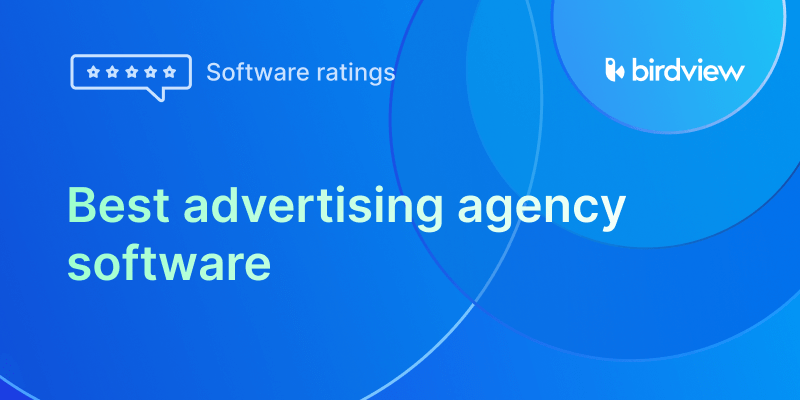Project Portfolio Management (PPM) software is essential for organizations seeking to manage their project portfolios effectively, ensuring optimal allocation of resources and alignment with overall business objectives. By providing tools to oversee and control multiple projects simultaneously, PPM software helps managers make informed decisions, balance risks, and achieve strategic goals.
What is Project Portfolio Management software?
Project Portfolio Management software assists organizations in centralizing the management of projects and resources across a company. This software typically includes functionality for project scheduling, resource allocation, budget management, risk assessment, and performance reporting. It offers a high-level view of all project activities and enables executives and managers to monitor progress and ensure projects align with business strategies.
Now, let‘s have a closer look at the 11 best PPM tools.
Best Project Portfolio Management software: 11 tools
Birdview
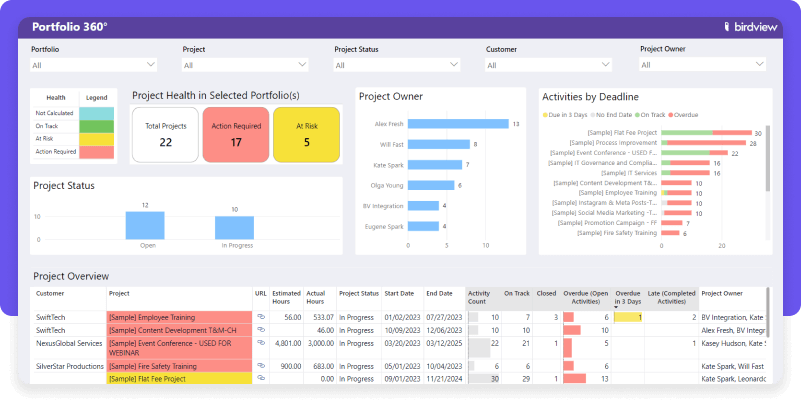
Birdview is a project and portfolio management platform designed to provide a comprehensive view of all projects across an organization. The platform offers a holistic approach to project and portfolio management, ideal for businesses looking to improve their project visibility and strategic decision-making. Its robust set of features supports complex projects across various industries, including technology, healthcare, and construction. Birdview is also known for its intuitive user interface and strong collaboration features.
Features: Real-time project dashboards, Business intelligence, Project planning and tracking, Portfolio management, Resource planning and scheduling, Cost and budget management, Time management, Customizable reports and business intelligence, Collaboration tools, AI tools
Pricing: Portfolio management functionality is available within the Birdview Project Management Team license for $19 per user per month. Prices for Birdview Enterprise plans are available upon request.
Trial: A free 14-day trial is available, with the possibility of extending the trial period to 28 days. Sign up for a trial today to learn more about Birdview.
What users say
Users of Birdview extensively praise its ability to manage every aspect of the project lifecycle efficiently, from initiation through to execution and closure. They like the tool for its intuitive design that facilitates easy scheduling of tasks and management of resources, making it particularly beneficial for portfolio management.
Portfolio management functionality is highly regarded for its efficiency and the ease with which users can schedule tasks and manage resources. Birdview’s capacity to provide clear visibility on project status, resource availability, and workload helps in effective decision-making and planning across multiple projects. Furthermore, its ability to integrate seamlessly with other tools enhances its utility in maintaining a cohesive workflow.
Users appreciate the software’s customization features, which allow them to tailor the system to their specific needs, ensuring that the management of project portfolios is both flexible and comprehensive.
Quickbase
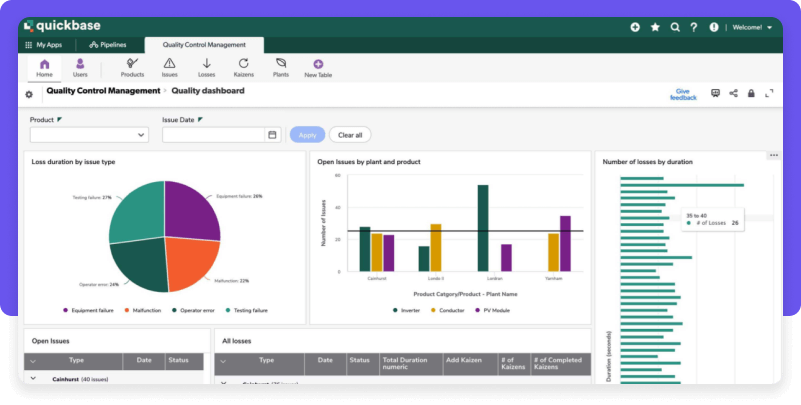
Quickbase allows users to build custom project management applications without extensive coding knowledge, making it ideal for teams that need tailored solutions. It empowers organizations to automate workflows and streamline data management, thereby enhancing decision-making and operational agility. Quickbase stands out for its ability to integrate complex data into actionable insights, facilitating better project outcomes.
Features: Drag-and-drop interface, Automated workflows and notifications, Real-time data analytics, App integration and building
Pricing: Starting at $35 per user per month.
Trial: A free 30-day trial is available.
What users say
Quickbase’s users frequently emphasize its strong capabilities in portfolio management, highlighting the platform‘s customization options and integrated functionalities that cater specifically to managing extensive project portfolios. They appreciate how Quickbase streamlines complex processes through automations, webhooks, and its ability to create tailored applications that align perfectly with business requirements.
However, some challenges are mentioned, such as integration issues with company domains and the need for more comprehensive guides for new features and updates.
Visit the website here.
MS Project & Portfolio Management
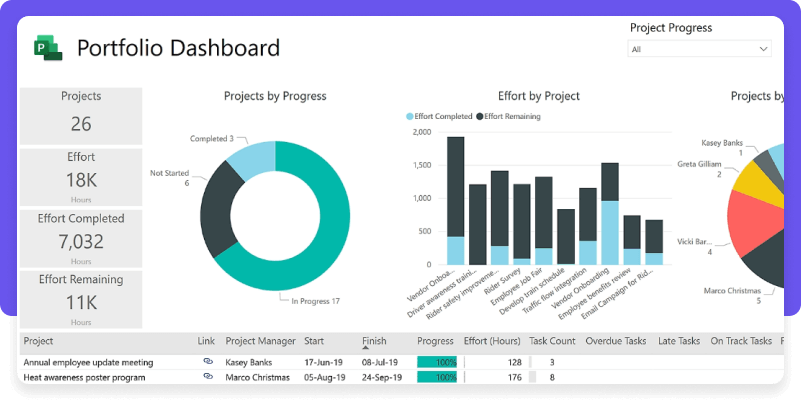
Microsoft Project & Portfolio Management is a powerhouse in the field, known for its detailed and scalable project planning tools. It integrates well within the Microsoft ecosystem, making it a natural choice for organizations heavily invested in Microsoft technology. The tool is designed to handle everything from small projects to large portfolios, providing detailed insights into resource allocations and project progress.
Features: Project scheduling and costing, Resource management, Reporting and business intelligence, Integration with Microsoft 365 suite
Pricing: Starting at $55 per user per month.
Trial: A free 30-day trial is available.
What users say
Users mention MS Project & Portfolio Management’s robust capabilities, particularly its comprehensive view of project timelines and ownership, which significantly boosts efficiency and ensures projects stay on track. The tool’s strong project planning and portfolio management features are consistently highlighted, allowing for detailed schedules, resource allocation, and easy tracking of all project components.
Some users point out that Microsoft PPM can be quite complex, especially for smaller projects or for those new to the system, which could lead to a steep learning curve. They also mention that the price of the tool is relatively high compared to other project portfolio management software.
Visit the website here.
Planview PPM Pro

Planview PPM Pro delivers comprehensive project portfolio management tools for mid to large-sized organizations. It enhances strategic execution by aligning projects with business objectives, thus offering features that aid in forecasting, resource management, and portfolio optimization. The software is powerful in facilitating the governance of large-scale projects, ensuring compliance and efficient resource usage.
Features: Strategic planning tools, Resource allocation and forecasting, Portfolio dashboards, Advanced reporting capabilities
Pricing: Prices are available upon request.
Trial: A free 30-day trial is available.
What users say
The Planview PPM Pro users highlight its comprehensive nature and how effectively it manages the entire lifecycle of projects. They appreciate the software’s robust feature set, which includes advanced request capturing, stage gating, and the ability to convert requests into projects while monitoring and capturing lessons learned.
The active customer community and responsive support from Planview, which often incorporates user-requested features into updates, are also highly praised. However, some users find that while the software is rich in features, the complexity can sometimes necessitate additional support from consultants, which may incur extra costs if service hours are exceeded.
Visit the website here.
Smartsheet

Smartsheet is a versatile PPM tool that emphasizes work automation and real-time collaboration. Smartsheet combines the flexibility of spreadsheets with project and portfolio management tools, making it easy for teams to transition from familiar applications while gaining enhanced functionality. Its capabilities support diverse project management needs, from simple task tracking to complex portfolio management.
Features: Automated workflows, Content collaboration, Integrations with leading apps like Microsoft and Google workspace, Secure sharing capabilities
Pricing: Project portfolio functionality is available within the Enterprise solution (prices are available upon request) and the Business plan as an add-on for $25 per user per month.
Trial: A free 30-day trial is also available.
What users say
Users of Smartsheet appreciate its ability to consolidate a vast range of project management functionalities into a single, adaptable platform, particularly highlighting its effectiveness in portfolio management. They value how Smartsheet facilitates the development of detailed plans and dashboards, allowing for a high level of customization and control over large portfolios.
However, some users express desires for enhancements in Smartsheet’s graphing options and more advanced portfolio visualization tools, such as the ability to easily plot projects in a quadrant matrix to evaluate their importance and impact.
Visit the website here.
Businessmap
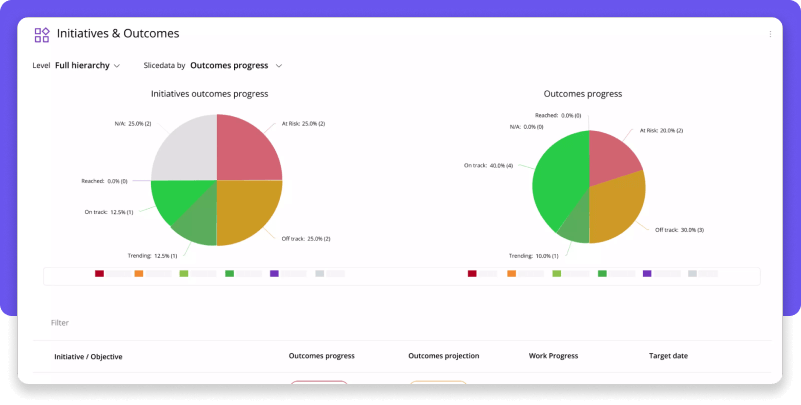
Businessmap is a lean project and portfolio management platform that gives teams full transparency across multiple portfolios. It helps organizations break down projects into manageable work items, visualize cross-team dependencies, and connect high-level company objectives with the execution of daily tasks.
With its comprehensive feature set, Businessmap enables users to track progress in real time, optimize workflows, and stay aligned on shared goals.
Features: Management dashboards and advanced Lean/ Agile workflow analytics, Interactive whiteboards, AI-powered tools, OKRs functionalities, Workflow automation capabilities, Integrations with third-party apps and custom solutions through API.
Pricing: Starting at $9/user/month with no limitation on all features.
Trial: A free 14-day trial is available.
What users say
Users describe Businessmap as an intuitive and flexible platform that enhances project visibility, supports agile methods, and helps connect company objectives with daily execution. They value its clear dashboards, customizable workflows, and strong collaboration features, noting that it improves decision-making, efficiency, and cross-department coordination.
Some users, however, mention a steep learning curve, and the need to dig deeper into the setup to get the most of it. Despite these points, most reviewers agree Businessmap delivers strong value in aligning strategy with execution.
WorkOtter

WorkOtter is ideal for small to medium-sized businesses that require a straightforward, no-frills approach to project management. It offers a user-friendly interface that simplifies project scheduling, resource management, and reporting. WorkOtter is particularly noted for its excellent customer service, and the ability to customize features to fit specific project management needs, making it a great entry-level option.
Features: Scenario planning, Resource leveling, Dashboard and reporting, Integration with MS Excel
Pricing: Project portfolio management functionality is available within the Manager license for $35 per user per month.
Trial: No free trial is offered.
What users say
Users of WorkOtter highly value its suite of features tailored for comprehensive project and portfolio management. The software is praised for its user-friendly interface, which simplifies the management of both single and multiple projects. Users also appreciate robust analytical tools such as Gantt charts, critical paths, and heat maps, which provide deep insights into project metrics and help manage projects more effectively.
Meanwhile, some users note limitations in task scheduling and the forecasting process, particularly when assignments are not linked to actual persons but rather to roles, which can reduce the robustness of project forecasts. Additionally, certain elements of the software, such as the Excel export function, are seen as outdated and less user-friendly compared to other platforms.
Visit the website here.
GanttPRO

GanttPRO uses intuitive Gantt charts to help teams plan, coordinate, and track their projects in real time. This tool is particularly appealing to visual planners and project managers who prioritize clear timelines and task dependencies. GanttPRO facilitates collaboration across team members and stakeholders, enhancing communication and ensuring project deliverables are met on schedule.
Features: Gantt chart-based planning, Time tracking, Resource management, Collaboration tools
Pricing: Project portfolio functionality is available within the Business plan for $19.99 per user per month.
Trial: A free 14-day trial is available.
What users say
GanttPRO is highly appreciated for its specialized focus on Gantt chart management, highlighting its utility in streamlining project planning and execution. The tool is lauded for its intuitive design and comprehensive feature set, which includes task management, deadline tracking, resource allocation, and portfolio management.
However, some users express a desire for more aesthetic customization options, like themes, and a simpler interface that resembles familiar tools like Excel.
Visit the website here.
Celoxis
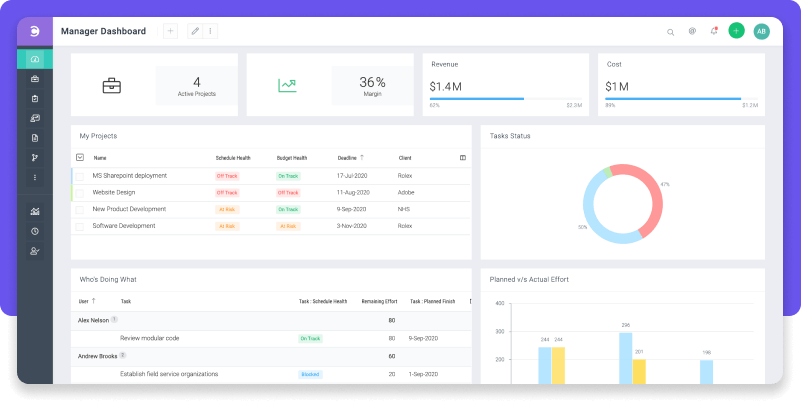
Celoxis is an all-encompassing PPM tool that offers extensive customization options and powerful analytics capabilities. It is designed for organizations that require detailed tracking of project performance, financials, and resources. Celoxis excels in delivering complex project reports and dashboards that provide critical insights for project managers and stakeholders to make informed decisions.
Features: Advanced scheduling, Custom dashboards and widgets, Time and expense tracking, Workflow automation
Pricing: Starting at 25$ per user per month.
Trial: A free 14-day trial is available.
What users say
The Celoxis users appreciate its comprehensive suite of project and portfolio management features, highlighting its ability to facilitate effective project planning, tracking, and resource management within a single platform. They also mention the positive impact of dynamic dashboards, customizable fields, and robust documentation and support.
A notable concern among users is the cost of Celoxis, which some find to be on the higher side compared to other project management solutions. This pricing structure may challenge small businesses or individuals operating on tighter budgets. Additionally, while Celoxis offers a mobile interface, some users find it less functional and harder to use for managing large projects on the go compared to the desktop version.
Visit the website here.
ClickUp

ClickUp offers a highly customizable interface that caters to various project management styles, whether Agile, Waterfall, or something in between. It aims to replace all productivity apps by centralizing tasks, docs, and emails in one place. This versatility makes ClickUp a top choice for teams seeking to minimize the clutter of multiple disjointed tools, enhancing overall productivity and team synergy.
Features: Custom views for tasks, Built-in time tracking, Goal setting and monitoring, Comprehensive reporting tools
Pricing: Starting at $7 per user per month.
Trial: No free trial is offered.
What users say
The tool is praised for its ability to integrate various management functions such as CRM, Kanban, and task management into a single platform, which significantly enhances visibility and coordination across projects. This centralization helps teams reduce the complexity and overhead associated with using multiple systems, thereby streamlining processes and increasing productivity.
However, some users note a steep learning curve due to its extensive features and suggest that the platform’s formula coding could be more user-friendly for those without a programming background.
Visit the website here.
Hive

Hive is designed for teams that need a flexible and powerful project management solution that adapts to their workflow. It combines AI-based analytics with conventional project management tools to automate tasks, manage timelines, and facilitate real-time collaboration. Hive‘s innovative approach to task management and data visualization makes it a preferred choice for dynamic teams looking to boost productivity.
Features: Flexible project views, Email integration, Automation tools, Time tracking
Pricing: The portfolio management feature is available within the Teams plan for $12 per user per month.
Trial: A free 14-day trial is also available.
What users say
Users like Hive for its ease of use, flexibility, and comprehensive project management features. Particularly, the Gantt chart, portfolio views, and robust reporting capabilities are frequently highlighted as key tools that aid in the efficient management of multiple projects and resources. Its customizable templates and views allow for tailored project management that fits various operational needs.
Some users report challenges with the platform’s functionality in specific areas. The inability to paste screenshots directly onto Hive cards and issues with setting up recurring tasks are noted as minor inconveniences. Additionally, users express a desire for more detailed progress tracking within tasks, as the current status options (Unstarted, In Progress, Complete) are seen as too limiting for complex project management.
Visit the website here.
How to choose the best PPM tool?
Choosing the right Project Portfolio Management (PPM) software for your organization is crucial to successfully managing multiple projects and aligning them with your business goals. Follow this detailed step-by-step guide to ensure you select the best tool to meet your needs.
Step 1: Assess your needs
Before exploring PPM tools, clearly define what you need the software to achieve. Consider the size of your project portfolio, the complexity of your projects, and specific challenges you are facing, such as resource management or reporting inefficiencies.
Step 2: Identify key functionalities
When selecting a Project Portfolio Management (PPM) tool, it is critical to identify the key functionalities that align with your organization’s needs. These functionalities should facilitate comprehensive management and oversight across all projects, ensuring effective execution and alignment with strategic goals.
- Task Management
This functionality should allow you to create, assign, and track tasks efficiently throughout the project lifecycle. Look for features that enable you to set deadlines, prioritize tasks, and update statuses as work progresses. Advanced task management tools may also offer dependencies management between tasks, enabling better planning and execution.
- Resource Allocation
Effective resource management is crucial in PPM. The tool should provide robust capabilities to schedule and allocate personnel and other resources across various projects. This includes visibility into resource availability, skill sets, and existing commitments to ensure optimal distribution and utilization of resources without overallocation.
- Budget Management
Financial control is a cornerstone of successful project management. The PPM tool should include features for tracking project budgets, expenses, and overall financial health. Look for capabilities that support detailed cost breakdowns, financial forecasting, and variance analysis to keep your projects on track financially.
- Risk Management
Identifying and mitigating risks is essential for project success. Your PPM tool should help you foresee potential risks and assess their impact on project objectives. Features include risk
identification, analysis, prioritization, and mitigation strategies. Such risk management tools will also provide options for ongoing monitoring and reporting on new and existing risks.
Additionally, consider the following advanced functionalities based on your specific needs:
- Portfolio analysis and reporting: To aid in strategic decision-making, choose a PPM tool that provides comprehensive reporting and analytics. This should include the ability to generate real-time reports on project status, portfolio health, resource utilization, and more. Customizable dashboards can help various stakeholders quickly access relevant information.
- Collaboration and communication: Look for features that promote collaboration among team members and stakeholders. This could include integrated chat functions, discussion boards, and tools for document sharing and version control. Effective communication features ensure that everyone involved in the project is aligned and informed.
- Integration capabilities: To maximize efficiency, your PPM tool should integrate seamlessly with other systems used by your organization, such as ERP systems, CRM software, and other productivity tools. Integration helps centralize data and processes, reduce errors, and save time.
Step 3: Consider usability
The best PPM tool is one that your team will actually use. Look for software with an intuitive interface that fits well with your team‘s skill set and current workflows. Consider requesting a demo or a trial period to evaluate the software‘s ease of use.
Step 4: Evaluate integration capabilities
Think about how the PPM tool will fit with your existing technology stack. The ideal PPM software should seamlessly integrate with other tools you use, such as CRM systems, ERP systems, and communication tools, to ensure smooth data flow and maintain consistency across platforms.
Step 5: Check scalability
Choose a PPM tool that can scale with your organization‘s growth. It should be able to handle an increasing number of projects and users without significant performance issues or the need for frequent upgrades.
Step 6: Analyze cost
Review the pricing structures of different PPM tools. Consider not only the upfront costs but also long-term expenses such as licenses, upgrades, and support services. Ensure the cost aligns with your budget and the expected return on investment (ROI).
Step 7: Read user reviews
Research what other users are saying about their experiences with the PPM tools you are considering. Look for reviews on software review platforms, forums, and industry websites to get a sense of the software‘s reliability, customer support quality, and overall user satisfaction.
Step 8: Make a decision
Based on your assessment, choose the PPM tool that best meets your criteria. It‘s often helpful to create a shortlist of potential options and compare them side-by-side to make an informed decision.
What challenges do organizations face when starting to use PPM tools?
Adopting new Project and Portfolio Management (PPM) software is a significant change for any organization, involving many layers of adjustment across departments. While PPM tools are designed to streamline project management processes and enhance efficiency, their introduction can be met with a range of challenges that can impede successful implementation and utilization.
Resistance to change
Change is often met with resistance, and introducing new PPM software is no exception. Employees may feel uncertain about new technology or worried about the impact on their current workflow. This resistance is typically rooted in a lack of understanding of the benefits the new system will bring and apprehension about having to learn new technologies.
Complexity of integration
Integrating new PPM software with existing IT infrastructure can be a daunting task. The challenge lies in ensuring compatibility between the new system and existing data systems, databases, and software applications, which can vary widely in architecture and age. Effective integration is crucial for the seamless flow of data across systems, yet achieving this can require significant time and technical expertise.
Training and onboarding
A major hurdle in the adoption of any new software is ensuring that all users are adequately trained. Without comprehensive training, users may feel frustrated and overwhelmed by the new system, leading to low adoption rates and failure to leverage the system‘s full capabilities. Effective training should be varied to accommodate different learning styles and must include ongoing support to address issues as they arise.
Data migration
Transferring existing data into a new PPM tool poses risks such as data loss, corruption, or significant downtime. Data migration challenges are compounded by the variety and complexity of data types and the need to maintain data integrity throughout the process.
Cost overruns
The financial investment required for PPM software can be substantial, and budgets can easily overrun due to unforeseen costs related to customization, additional features, or extended implementation timelines. Managing these costs requires meticulous planning and constant monitoring.
Underutilization
Often, organizations do not fully utilize all the features of a new PPM tool, either because they are unaware of them or because they do not understand how to apply them effectively. This underutilization can result in missed opportunities to enhance efficiency and project outcomes.
How to maximize the use of PPM software?
Successfully implementing and maximizing the use of project portfolio management software requires more than just selecting the right tool. It involves a strategic approach to ensure that the technology is adopted and utilized effectively across the organization. With deliberate planning, comprehensive training, and ongoing support, these challenges can be overcome, allowing enterprises to leverage the benefits of their PPM tools fully. Here are some practical strategies that organizations can employ to not only navigate these challenges but also enhance the effectiveness and impact of their PPM tools.
- Effective change management can smooth the transition to new PPM software. This involves clear communication about the benefits and impacts of the new system, as well as involving key stakeholders in the planning and implementation phases to foster a sense of ownership and acceptance across the organization.
- Map out the integration process by collaborating closely with IT specialists and software vendors from the outset. Ensure that the PPM tool can integrate smoothly with existing systems to facilitate efficient workflows and data consistency.
- Develop a detailed training program that addresses the needs of all users, from novices to advanced users, and include hands-on training sessions to build confidence. Offer continuous learning opportunities to keep staff updated on new features and functionalities.
- Approach data migration with meticulous planning, including pilot testing and data integrity verification. Ensure robust backup and recovery processes are in place to handle any data loss or corruption issues.
- Maintain strict oversight of project budgets and manage expectations around costs. Regularly review expenses related to the PPM software to ensure they align with organizational objectives and expected returns.
- Regularly train and encourage users to explore all features of the software. Hold regular sessions to demonstrate useful features and share best practices to ensure users feel comfortable and empowered to use the system to its full potential.
- Establish a feedback loop with users to gather insights on their experiences with the PPM tool continually. Use this feedback to make adjustments and improvements to both the tool and the training program.

